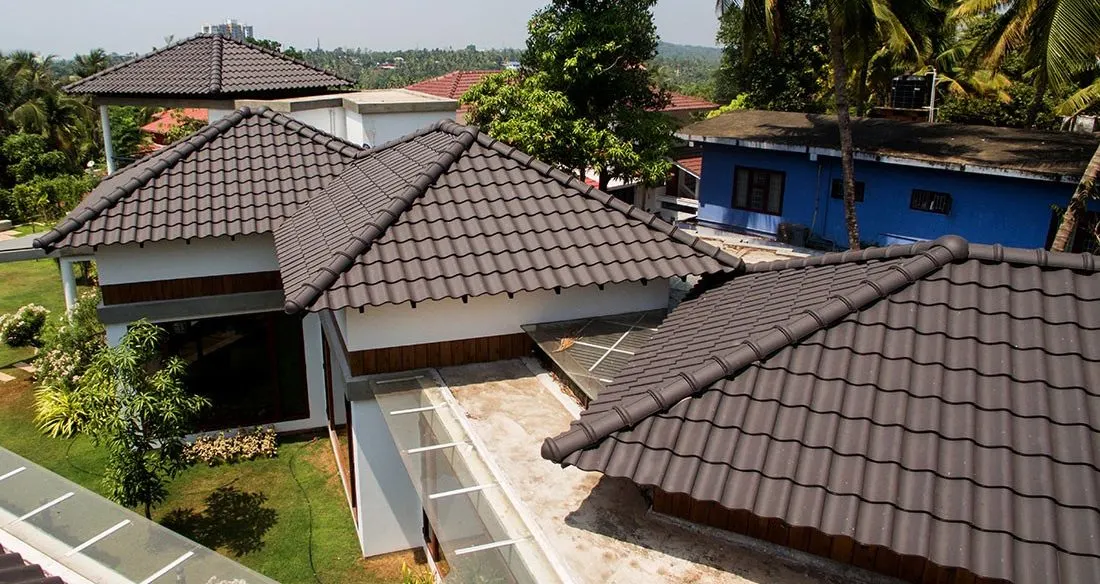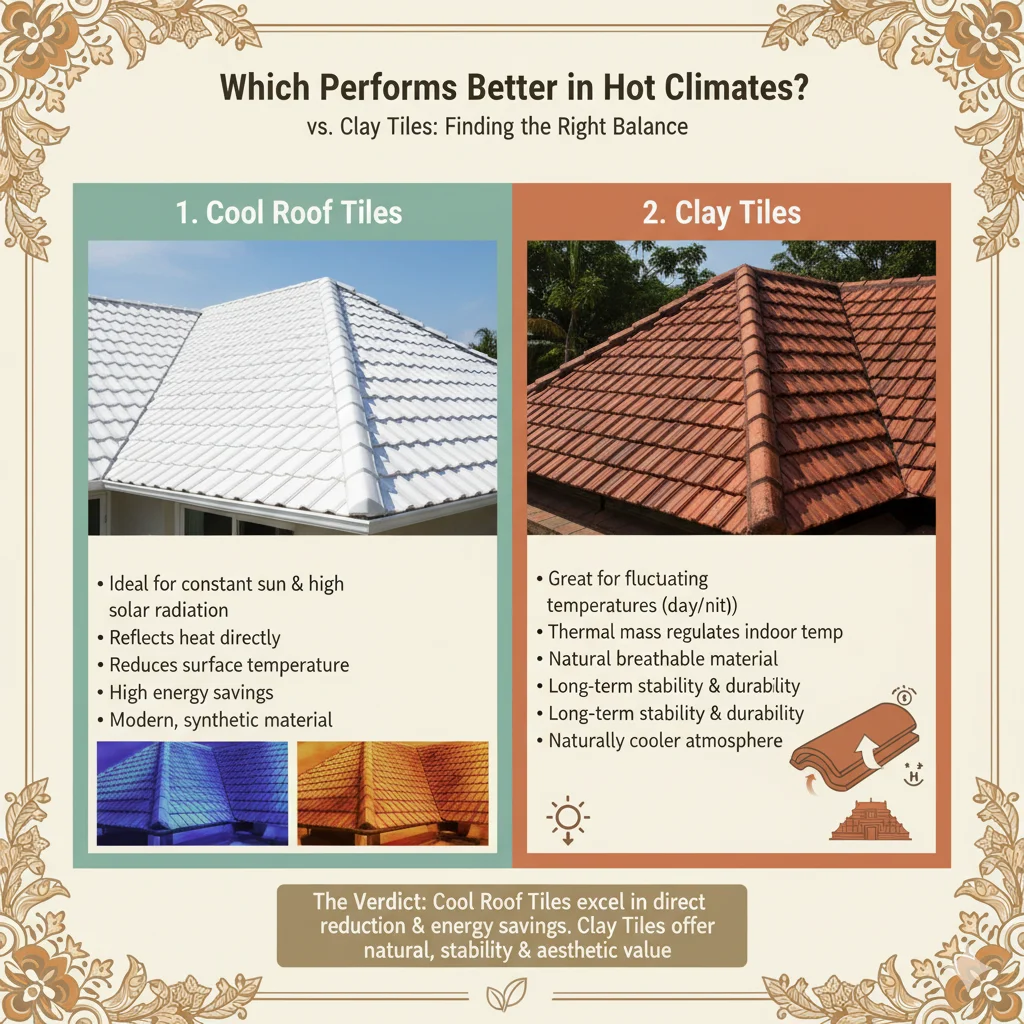Nov 09, 2025
Connect With Our Team
Cool Roof Tiles vs Clay Tiles: Which Keep Homes Cooler?
- Home
- Utilities
- News & Blog
Introduction
In humid and hot climates, a challenge is always present to keep homes cool naturally without causing too much use of power. The roofing material that you use may have a lot of impact on the internal temperature, comfortability and energy bills. One of the most used ones includes such materials as cool roof tiles and clay tiles: these types of tiles are aimed at minimizing the heat accumulation, but in quite different forms.
Such comparison examines the performance of all roofing solutions in the real world environment and this will assist the home owners in making a sound decision that is comfortable, affordable and sustainable.
What Are Cool Roof Tiles?

Cool roof tiles have been designed to reflect a greater amount of sunlight and absorb less heat than normal roofing materials. These tiles are made of reflective compounds or they are painted with special pigments that reduce the quantity of solar radiation that is taken up by your roof.
They have the main benefit in terms of the Solar Reflectance Index (SRI) which is related to the ability of the surface to reflect sunlight. The greater the SRI the less the heat is absorbed, thus it can lower indoor temperature up to 5 -10°C during peak summer months.
Homeowners can also have the advantage of their indoor spaces being cooler and their air-conditioning bills cut by installing the cooling tiles that cool down the terrace spaces.
Key benefits include:
-
Reflective roof lowers the temperature of roof
-
Saving of energy as a result of reduced cooling requirements.
-
Better coolness in warm conditions.
-
Green and sustainable substance.
What Are Clay Tiles?

On the other hand, clay tiles have been used in traditional architecture since hundreds of years ago. They are durable, beautiful, and insulative and made of natural clay and fired at high temperatures.
The most popular variants include:
-
Clay roof tiles and terracotta roof tiles for traditional rooftops.
-
Terracotta wall tiles and clay cladding tiles for exterior facades.
-
Terracotta floor tiles and terracotta patio tiles for courtyards and verandas.
These terracotta clay tiles are microscopic and this traps heat in the tiles that make the interior naturally cooler. They are a classic in tropical areas due to their porous nature that enables them to be cool and warm at the same time.
Advantages of clay tiles:
-
Excellent natural insulation properties.
-
Long lifespan with minimal maintenance.
-
Classic aesthetic with earthy tones.
-
100% recyclable and eco-friendly.
How Do Cool Roof Tiles Keep Homes Cooler?
-
Reflectivity and Emittance: Cool tiles are highly reflective (SRI) which bounces the solar energy and emits the heat absorbed and away from the building.
-
Temperature Reduction: Is also capable of reducing the indoor temperatures to a few degrees lower than that of conventional tiles.
-
Energy Savings: Minimized use of air conditioning means less energy payment in hot weather.
How Do Clay Tiles Regulate Temperature?
-
Thermal Mass: Clay tiles store heat in the daytime and dissipate heat at night, eliminating variations in temperature.
-
Natural Insulation: They are built in such a way that air can circulate beneath them insulating interiors further.
-
Heat Absorption & Release: They capture a little of the sun's energy, yet, because of thermal mass, they retain the heat in the house.
Which Keeps Homes Cooler: Cool Roof Tiles or Clay Tiles?
It is the most important question that is being posed by homeowners.
Cool roof tiles are able to reflect sunlight because they have a high albedo surface thus it does not absorb heat. In the meantime, clay roof tiles absorb a certain amount of heat but it is slow to release and as a result indoors temperatures stay stable.
Cool roof tiles in hot weather are expected to do a little better in reducing surface temperature due to their reflection ability. Nonetheless, clay tiling will be the best to insulate the building passively to minimize daytime temperature variations.
Cool Roof Tiles vs Clay Tiles: Key Comparison
| Feature | Cool Roof Tiles | Clay Tiles |
|---|---|---|
| Heat Reflection | Very High | Moderate |
| Heat Absorption | Low | Medium |
| Insulation | Moderate | High |
| Maintenance | Low | Medium |
| Aesthetic Appeal | Modern | Traditional |
| Eco-Friendliness | High | High |
| Energy Savings | Higher in hot regions | Moderate, long-term |
| Durability | 15–25 years (depends on coating quality) | 40–75 years (with proper maintenance) |
Which Performs Better in Hot Climates?

In the case of hot climates, the two roofing types have merits, however, they perform well in most different areas.
-
Cool Roof Tiles: It works well in areas that are always hot and sunny and have high levels of solar radiations as the primary issue. Their reflective capabilities bring down the surface temperatures directly.
-
Clay Tiles: Can be used where temperatures change widely during the day and night because the thermal mass of these tiles corrects the internal heat conditions.
Cool roof tiles can perform highly in direct metrics concerning energy savings and reduction of surface temperature, whereas clay tiles have greater long-term stability and can provide a naturally cooler atmosphere without using a coating or synthetic material.
Which Roofing Solution Is Right for You?
Choosing between cool roof tiles and clay tiles depends on several key factors:
-
Climate: Cool roof tiles are perfect in extremely hot and sunny places. In areas where the heat is moderate and the nights are cooler, clay tiles are superior in terms of temperature control.
-
Budget: The cool roof tiles can be expensive in the short run, but save energy costs quicker. Clay tiles are a long term investment in regard to durability and beauty.
-
Aesthetics: Clay tiles have a classic and natural appearance with earthly tones that goes with the traditional or Mediterranean-style house, whereas the cool roof tiles come in an extensive variety of contemporary finishes and colors.
Cool roof tiles can be the choice of homeowners who pay much attention to energy efficiency and the modern character, whereas those who care more about heritage and natural materials can use clay tiles.
Conclusion
Both cool roof tiles and clay tiles offer effective ways to keep homes comfortable in hot climates each using different mechanisms. Cool roof tiles excel in reflecting solar heat and improving energy efficiency, while clay tiles provide natural insulation and timeless charm.
Ultimately, the right choice depends on your climate, budget, and design preferences. For sustainable cooling and reduced electricity costs, cool roof tiles are a modern solution. For lasting durability and traditional appeal, clay tiles remain unmatched.
Either way, investing in thermally efficient roofing ensures a cooler, greener, and more comfortable home for years to come.
Harsha Tiles offers a range of cool roof tiles, including options like Checkers White, Plain White, and Checkers Grey, which are designed to reflect sunlight and maintain cooler indoor temperatures.
Ultimately, the choice between cool roof tiles and clay tiles depends on your specific needs, budget, and aesthetic preferences. By considering factors like heat reflection, durability, and design, you can make an informed decision to enhance your home's comfort and energy efficiency.
People Also Ask
1. Which type of roof tile keeps a house cooler in summer?
Cool roof tiles reflect more sunlight, keeping your roof surface cooler. Clay tiles, however, provide better insulation, maintaining comfortable temperatures indoors.
2. Are cool roof tiles better than clay roof tiles?
If energy efficiency and modern appearance are priorities, cool roof tiles are the better choice. For natural aesthetics and long-term insulation, clay tiles excel.
3. Can I use clay or terracotta tiles for terraces?
Yes, terracotta patio tiles and clay floor tiles are perfect for terraces, providing slip resistance and a cooler surface underfoot.
4. How do clay tiles regulate temperature?
Clay tiles contain natural air pockets that trap and slowly release heat, acting as thermal insulators.
Latest Blogs
Got questions? Fill out the form and get in touch with us!
Harsha Tiles
21,22 Cowley Brown Road ,
R.S. Puram,Coimbatore – 641002.
2025 Harsha Tiles | Design And Managed By : LLS - INDIA
Whatsapp Chatx
Hi! Click one of our representatives below to chat on WhatsApp or send us email to info@harshatiles.in
 |
Mr Saleem +91 82702 80707 |
 |
Mr Martin +91 78688 86655 |

We will love to hear from you!


